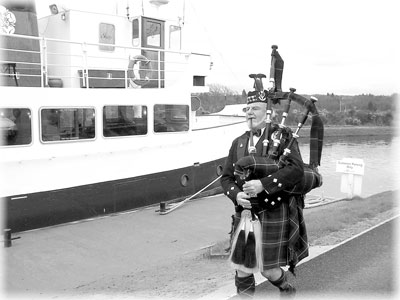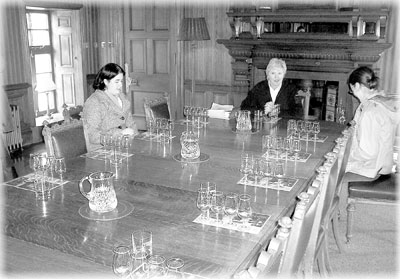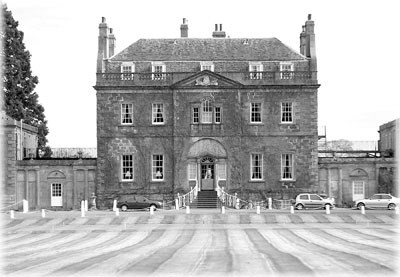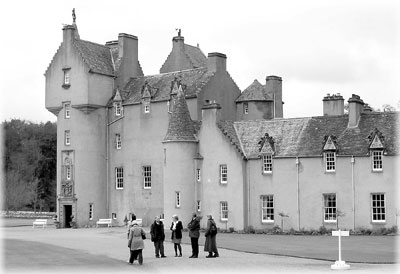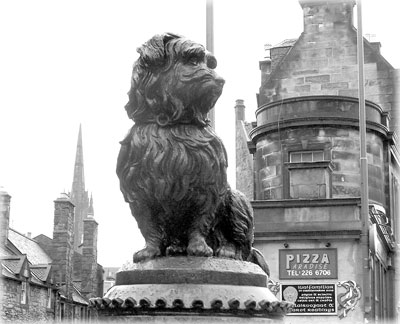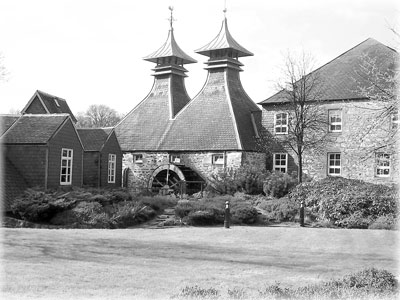A wee taste of Scotland
by Steve Venables, Contributing Editor
I flew to Scotland in April ’05 for a travel exposition in Aberdeen. Aberdeen is Scotland’s third-largest city, but the locals I talked to said that tourists often skip it. There’s actually quite a lot to see, however. With dozens of nearby castles, distilleries and golf courses, Aberdeen is a good center from which to enjoy this part of Scotland.
Aberdeen
We stayed at the Norwood Hall Hotel (fax +44 1224 869868 or visit www.norwood-hall.co.uk) in Aberdeen. Located in the country and set back from the road, it is about five miles southwest of the town center.
A private residence in the early 19th century, it is old and charming, with a bright breakfast room, a cozy bar and meeting or sitting rooms. My room, on the second floor, was comfortable, with updated facilities. Including tax and breakfast, the price ranged from £120 to £300 ($212-$532) a night, depending on the season and room type.
When I inquired at the front desk about local walks, I was directed to the old Deeside Railway line that has been shut down since 1966. The railbed is now a walking/cycling trail, one that allowed me to stroll into town in less than an hour. Everyone I encountered gave me a friendly greeting and I wondered if they could tell I was an American or if this was just their custom.
Queen Victoria used to ride the old Deeside Railway from Aberdeen on her way to Balmoral Castle, the summer residence of the royal family. Within easy driving distance of Aberdeen, Balmoral today is usually open to the public from April though July.
Whisky tasting
We left Aberdeen early and drove along the A96 freeway to Inverness. Along the way we stopped near the town of Keith to visit the Strathisla Distillery (fax +44 1542 783039; www.chivas.com). It’s the home of Chivas Regal and is open daily from April 1st to October 31st (10-4 Monday-Saturday and 12:30-4 Sunday). Admission is £5.
Founded in 1786, it’s the oldest working distillery in The Highlands. We were able to tour the distillery with its vats and copper tanks as well as the storage barns where barrels of whisky are aged, sometimes for 24 or more years.
At the end of the tour we were given a tasting of four whiskies, much like a wine tasting — swirl your glass; observe the color; sniff the inside of your glass; note the peat, chocolate or smoky aroma, then sip a little, allowing it to first rest on your tongue before swallowing.
Inverness
After our visit to Strathisla, we drove into Inverness to the Tomnahurich Bridge, where we boarded Jacobite Cruises’ flagship, Jacobite Queen (phone +44 1463 233999; www.jacobite.co.uk). A piper in full Scottish plaid strode back and forth at the gangplank, puffing the announcement of our sailing. We departed on the pleasant 3-hour “Reflection” cruise to the Dochgarroch Locks and into Loch Ness, destined for Urquhart Castle.
Sandwiches were served, and the small bar had drinks available. The Queen accommodates 50 sit-down passengers, plus there was lots of outside deck area to better spy the famous monster, “Nessie.” Admission to the ruins and visitors’ center at Urquhart Castle was included in the £13.50 fare.
Upon returning to Inverness, we traveled through the outskirts of town, then passed the historic battlefield on Culloden Moor where, in 1746, Scottish Highlanders failed in their charge for the first and last time against British troops. Many were slaughtered, along with their dream of an independent Scotland.
Our hotel for the night was Culloden House (fax +44 1463 792181; www.cullodenhouse.co.uk). The original house was used by Bonnie Prince Charles as his lodging and battle headquarters during the battle of Culloden. Later, the house was partially destroyed, then rebuilt, staying in private hands until 1975 when it was remodeled as a fine country-house hotel. The Palladian-style house is situated on 40 acres of lawns and parklands, with a pasture in the back for longhaired Highland cattle.
As it was off-season, I think we may have been the hotel’s only guests. At any rate, it was a pleasure enjoying its majestic architecture and elegant antiques. And, having had our dinner there, I can say the dining was absolutely superb — fit for a prince. Rooms start at £155 ($271) single and £210 ($367) double.
After breakfast we drove into the center of Inverness to get a better look at the town. For some reason, I thought Inverness would be bigger. Nevertheless, it’s the cultural and business center of the area, with its Victorian Market in the Old Town linking the town’s busiest streets.
There are lots of specialty shops selling knitwear, books, music, crafts, food, kilts and local artwork. However, because we arrived early, many shops had not yet opened.
I noticed that Inverness has an abundance of small bed-and-breakfasts lining both sides of the boulevards into town, and many people make this their home base while touring the Highlands.
To learn more about Inverness, visit www.inverness-scotland.com.
Ballindalloch Castle
Now for the really good stuff. We left Inverness and drove an hour and a half to one of Scotland’s most beautiful and renowned estates, Ballindalloch Castle. Ballindalloch is my idea of what a castle should look like.
Known as The Pearl of the North, it has been lived in continuously by the founding family since 1546. Its grounds are meticulously groomed and include open lawns, spellbinding flower gardens and thick woods beyond the castle leading down to the veiled Spey River.
We were met at the entrance by the present Laird of Ballindalloch, Clare MacPherson-Grant. Over six feet tall and with chestnut hair, blue eyes and a gracefully disarming charm, she was quick to explain that she had been an only child and became Scotland’s first female laird upon the death of her parents.
She shared a little history of the castle and told us what it was like living there as a youth and about returning to live in it again with her husband and family. She also told of finding old paintings forgotten in the tower, making her now the owner of one of the largest collections of Spanish art outside of Spain.
After our greeting, we were turned loose to have a snoop around. At the exit we found the gift shop, offering silk and tartan presents plus locally made honey and jams. And the Castle Tea Room was ideal for a soup-and-sandwich break.
A modest fee (£7 for the castle and grounds) is charged to visit the castle, which is open daily, except Saturdays, from 10:30 a.m. to 5 p.m. from mid-April to the end of September. It also offers a 9-hole golf course, river walks and a play area for children. For more information, visit www.ballindallochcastle.co.uk.
Edinburgh
Arriving in Edinburgh a little after 6 p.m., we checked into our hotel, freshened up and headed back out for dinner at Le Marche Noir (phone 0131 558 1608; www.ducks.co.uk). We went there because of its reputation for fine Scottish food and its unique decor.
The restaurant is owned and operated by Malcolm Duck, whose last name inspired the restaurant’s decor. Ducks are in evidence everywhere.
Besides the classic Scottish dishes, which, by the way, were not bland, we were treated to some excellent wines from what is claimed to be one of the finest wine cellars in Scotland. Finally, just before dessert, Malcolm insisted that we try some of his haggis — not bad, not bad at all. Entrées range from £13.50 to £21.50 ($23.50-$37.50).
Our hotel, Number Ten Hotel Apartments (10 Gloucester Pl., fax +44 131 220 4706; www.hotelnumberten.com), was a new 5-star accommodation. It is near central Edinburgh in a residential area composed of million-dollar 3- and 4-story 19th-century townhouses. While the outside of the original building in which it is housed remains unaltered, the interior has been transformed by a leading-edge modern makeover. My large room had a kitchenette along one wall and windows overlooking the quiet street. (Rooms range from £98 to £180, or $174-$319, per night, depending on the season.)
From the outside, you cannot tell it’s a hotel — there is no sign nor lobby. We checked in at the more obvious parent hotel a few doors down and used its lobby, bar and breakfast room when desired.
On our last day we visited Edinburgh Castle, a not-to-be-missed historical attraction. We also toured Mary King’s Close. A close was a pathway off a street where people built homes and shops facing it on either side just a few feet apart. The buildings grew up along with the population until the sky was nearly blocked out.
Because there was no sanitation, by the 17th century the closes were filthy. People would simply chuck their garbage and waste into the path out their windows or doors. The wealthy moved to the higher floors at first, then eventually to better neighborhoods.
Most closes disappeared in the 20th century, but Mary King’s was abandoned and built over. Its rooms were used as basement-like storage until 2003, when they were resurrected as a tourist attraction.
Guides in period costume escorted us along the now-subterranean pathway and through the buried buildings, offering theatrical narration of their history and characters.
That evening’s dinner was at VinCaffè (phone 0131 557 0088; www.valvonacrolla.co.uk), in Multrees Walk, offering a variety of Italian food, pizzas and wine. Owned by Valvona & Crolla, it was opened in 2004 to celebrate their 70th anniversary.
Valvona & Crolla was founded in 1934 to serve the Italian immigrant community in old Edinburgh. It is now Scotland’s oldest delicatessen and Italian wine merchant. Chock-full of cheeses, breads, wines and salamis from floor to ceiling, this family-run specialty food business is worth a peek.
Steve Venables was a guest of VisitScotland. For info on Scotland, call 800/462-2748 or visit www.toscotland.com.


